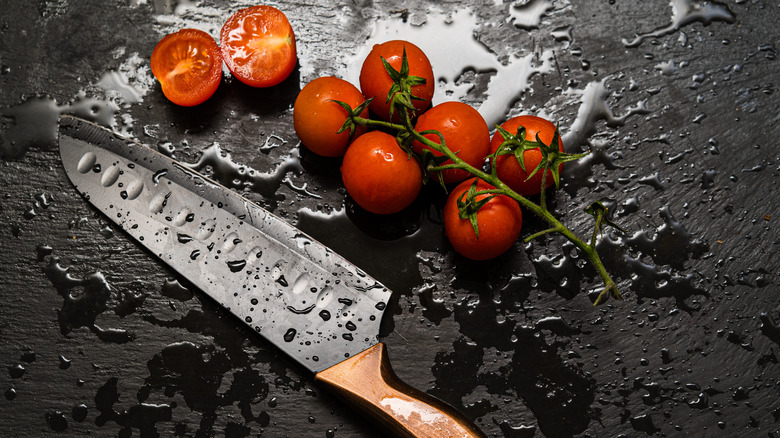What Makes A Santoku Knife Different From A Western Chef's Knife?
One of the most important tools in any kitchen is a good collection of knives. Whether you're cutting meats, vegetables, or even some chocolate for baking, having the right blade for the job is essential. Not only will this ensure that you have the best results from your cooking, but it can be a matter of safety too, as not maintaining knives, or misusing them can lead to accidents.
As NBC News points out, when considering a kitchen knife upgrade, it is best to go with a higher standard of knife. While there are tons of highly specialized knives out there, most chefs will work with a handful of workhorses to get the majority of their prep and cooking accomplished. Consumer Reports says that one of the most widely used knives is a chef's knife. A classic European-style chef's knife might suit your needs perfectly, but there is another option to consider — the Santoku knife.
According to Kamikoto, Santoku-style knives are originally from Japan, and they feature a unique set of attributes that makes them well-suited as workhorse knives in the kitchen. In fact, this special knife includes a few advantages over a standard chef's knife.
Santoku knife features
Russums points out that the Santoku knife's versatility is most clearly illustrated in its name. Indeed, "Santoku" roughly translates to "three uses" because they are well suited to chopping, slicing, and mincing a wide variety of foods. Of course, the same could be said for a Western chef's knife, but Santoku knives stand out in more ways than one.
Made In Cookware claims that what sets Santoku knives apart is that they are typically made of harder and thinner steel. This allows the blade to have greater precision and make extra fine cuts. When you think of the ultra-thin and exacting nature of cutting fish for sushi, then you can understand why this level of precision is necessary.
Kamikoto adds that the shape of the Santoku, which has a flatter cutting edge, also requires a different cutting technique. It's important to master all the basic knife cuts, but the Santoku knife's blade will not be suited to the "rocking method" that many western chefs use. The chef's knife has a more curved blade which lets it rock easily, but the Santoku's flatter blade requires a slicing and chopping style instead that doesn't pivot on the board. Kamikoto points out that this technique is faster than the rocking method, but may require a new skill set for some.
Choosing the right beveling style
Another common feature of the Santoku knife is a single beveled edge. According to Kamikoto, this means that the blade is only sharpened on one side of its cutting edge while the other side remains flat. If you were able to see the edge under a microscope, this single bevel would give it a wedge-like appearance. A double beveled edge on the other hand is sharpened on both sides giving it a v-shape appearance.
Russums says that there are more double-bevel Santoku knives available today that are more of a hybrid style of knife, but the originals were almost exclusively single bevels. Kamikoto further notes that the advantage of the single bevel is that it has a more shallow angle on its edge, which helps it make ultra-thin, precise cuts. Vertoku says that the typical angle for this edge is about 15 degrees, while a double bevel edge is usually closer to 30 degrees on either side.
All of the Santoku knife's features combine to make it both a workhorse of a kitchen knife, and also capable of completing ultra-precise cuts for those that have a more skilled hand.


